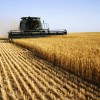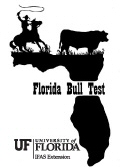 Higher wheat prices created the impetus for growing wheat in the southeastern United States. Since increasing amounts of corn have been diverted to ethanol production, there is a shortage of grain for America’s livestock industry. This shortage results in higher wheat and soybean prices. Wheat and soybean have been grown together as a double crop throughout the Southeast for many years, which generally increases profitability compared with growing only one of the crops. Planting wheat followed by cotton, peanut or grain sorghum has also become a common practice. The best management practices for high yields of wheat in the Southeast Coastal Plain are well established. This 3-page fact sheet lists production practices for small grains in Florida. Written by D.L. Wright, A.R. Blount, R.D. Barnett, C.L. Mackowiak, N. Dufault, and J. Marois, and published by the UF Department of Agronomy, October 2013.
Higher wheat prices created the impetus for growing wheat in the southeastern United States. Since increasing amounts of corn have been diverted to ethanol production, there is a shortage of grain for America’s livestock industry. This shortage results in higher wheat and soybean prices. Wheat and soybean have been grown together as a double crop throughout the Southeast for many years, which generally increases profitability compared with growing only one of the crops. Planting wheat followed by cotton, peanut or grain sorghum has also become a common practice. The best management practices for high yields of wheat in the Southeast Coastal Plain are well established. This 3-page fact sheet lists production practices for small grains in Florida. Written by D.L. Wright, A.R. Blount, R.D. Barnett, C.L. Mackowiak, N. Dufault, and J. Marois, and published by the UF Department of Agronomy, October 2013.
http://edis.ifas.ufl.edu/ag293
Tag: North Florida Research and Education Center
The Florida Bull Test 2011-2012 (AN284)
 The North Florida Research and Education Center in Marianna, Florida annually hosts the Florida Bull Test. By controlling the environmental factors and taking Expected Progeny Differences (EPD’s) into account, the data clearly emphasizes the dual importance of genetics and environment in all cattle types. This 5-page fact sheet presents the procedures, rules, and results of the 2011-2012 test. Written by G. Cliff Lamb and Nicolas DiLorenzo, and published by the UF Department of Animal Sciences, December 2012.
The North Florida Research and Education Center in Marianna, Florida annually hosts the Florida Bull Test. By controlling the environmental factors and taking Expected Progeny Differences (EPD’s) into account, the data clearly emphasizes the dual importance of genetics and environment in all cattle types. This 5-page fact sheet presents the procedures, rules, and results of the 2011-2012 test. Written by G. Cliff Lamb and Nicolas DiLorenzo, and published by the UF Department of Animal Sciences, December 2012.
http://edis.ifas.ufl.edu/an284
“Earlyploid”: Tetraploid Annual Ryegrass (SSAGR355/AG364)
 Earlyploid, developed at the UF/IFAS North Florida Research and Education Center, is a large-seeded, upright, early forage-producing and early maturing annual ryegrass. Regional variety trials show it is the earliest tetraploid ryegrass cultivar available commercially. It offers excellent disease resistance and sufficient cold tolerance to be grown successfully in the southern annual ryegrass region of the U.S. This 1-page fact sheet was written by A.R. Blount, G.M. Prine, C.L. Mackowiak, K.E. Kenworthy, J.C. Jones, and P.E. Reith, and published by the UF Department of Agronomy, October 2011.
Earlyploid, developed at the UF/IFAS North Florida Research and Education Center, is a large-seeded, upright, early forage-producing and early maturing annual ryegrass. Regional variety trials show it is the earliest tetraploid ryegrass cultivar available commercially. It offers excellent disease resistance and sufficient cold tolerance to be grown successfully in the southern annual ryegrass region of the U.S. This 1-page fact sheet was written by A.R. Blount, G.M. Prine, C.L. Mackowiak, K.E. Kenworthy, J.C. Jones, and P.E. Reith, and published by the UF Department of Agronomy, October 2011.
http://edis.ifas.ufl.edu/ag364
“Ocala”: A New Diploid Annual Ryegrass for the Southern U.S. (SSAGR356/AG365)
 Ocala, a new UF annual ryegrass, has excellent disease resistance and sufficient cold tolerance to be grown successfully in the southern annual ryegrass region of the U.S. It is a well-adapted, diploid annual ryegrass population. Parentage includes several advanced experimental annual ryegrass populations for Florida and Nebraska. This 1-page fact sheet was written by A.R. Blount, G.M. Prine, K.E. Kenworthy, P. Mislevy, J.C. Jones, and P.E. Reith, and published by the UF Department of Agronomy, October 2011.
Ocala, a new UF annual ryegrass, has excellent disease resistance and sufficient cold tolerance to be grown successfully in the southern annual ryegrass region of the U.S. It is a well-adapted, diploid annual ryegrass population. Parentage includes several advanced experimental annual ryegrass populations for Florida and Nebraska. This 1-page fact sheet was written by A.R. Blount, G.M. Prine, K.E. Kenworthy, P. Mislevy, J.C. Jones, and P.E. Reith, and published by the UF Department of Agronomy, October 2011.
http://edis.ifas.ufl.edu/ag365
Pecan Cultivars for North Florida (HS106)
 Pecan recommendations for Florida have been updated to include new information about cultivar performance. Check out this 13-page fact sheet to select the best cultivars for yield, performance, resistance to disease, and resistance to limb breakage. Written by Peter C. Andersen, and published by the UF Department of Horticultural Sciences, September 2011. (UF/IFAS Photo: Thomas Wright.)
Pecan recommendations for Florida have been updated to include new information about cultivar performance. Check out this 13-page fact sheet to select the best cultivars for yield, performance, resistance to disease, and resistance to limb breakage. Written by Peter C. Andersen, and published by the UF Department of Horticultural Sciences, September 2011. (UF/IFAS Photo: Thomas Wright.)
http://edis.ifas.ufl.edu/hs106
Annual Warm-Season Legumes for Florida and the US Gulf Coast: Forage Yield, Nutritional Composition, and Feeding Value (AN259)
High-quality forage legumes that can be grown during the warm-season are scarce in Florida and the Gulf Coast region. Seeded warm-season legumes, such as cowpea, soybean, and pigeonpea, are less expensive and faster to establish than perennial peanut, and they could provide nutritious forage to complement beef cattle and other ruminant animal feeding programs. This 5-page fact sheet summarizes the results of three years of field trials and two feeding trials conducted at North Florida Research and Education Center in Marianna, located in northwest Florida. Written by Jamie Foster, Robert Myer, A.T. Adesogan, Jeffery Carter, Lynn Sollenberger, and Ann Blount, and published by the UF Department of Animal Science, January 2011.
http://edis.ifas.ufl.edu/an259
Camelina Production in Florida (SSAGR340/AG350)
Camelina (Camelina sativa (L)) is an old-world crop used primarily for oil. It can be grown under semi-arid conditions. Breeding efforts have resulted in very few improvements. It is a member of the Brassicaceae or mustard family and related to canola and cole crops. The seed is about 35% oil, and the oil is high in omega-3 fatty acid, which has been cited as having health benefits. Camelina meal can be fed to livestock, producing eggs and meat that are higher in omega-3 fatty acids. Interest in camelina is not only due to its high level of omega-3 fatty acids but because it is a renewable source of feedstock for biodiesel and advanced biofuels.
This 3-page fact sheet was written by David Wright and Jim Marois, and published by the UF Department of Agronomy, February 2011.
http://edis.ifas.ufl.edu/ag350
WEC269/UW314 Forest Groundcover Restoration
WEC269, a 5-page illustrated fact sheet by Holly K. Ober and Jennifer L. Trusty, provides an overview of seven steps to follow for a successful groundcover restoration project. Includes references. Published by the UF Department of Wildlife Ecology and Conservation, November 2009.
http://edis.ifas.ufl.edu/UW314
HS1155 Production and Marketing of Chestnuts in the Southern United States
HS-1155, a 9-page illustrated fact sheet by Robert C. Hochmuth, Robert D. Wallace, Peter J. Van Blokland, and Jeffrey G. Williamson, provides information about these species of the beech family, which could make a viable alternative crop for small farmers in Florida who are looking to diversify their operations — history, economics, species and hybrids, nut quality and grades, propagation, location and site, orchard planting and production, pruning, pest management, pollination and nut formation, harvesting and storage, processing, marketing, and nutrition. Published by the UF Horticultural Sciences Department, July 2009.
http://edis.ifas.ufl.edu/HS1155
SSAGR323/AG333 Peanut Variety Performance in Florida, 2005 – 2008
SS-AGR-323, a 14-page illustrated fact sheet by Barry Tillman, Mark Gomillion, George Person, Justin McKinney and Bill Thomas, provides data from University of Florida trials conducted in Florida at IFAS research centers located in Gainesville (Citra), Marianna, and Jay from 2005-2008. Published by the UF Department of Agronomy, July 2009.
http://edis.ifas.ufl.edu/AG333
HS1020/HS255 Greenhouse Manufacturers and Suppliers
Revised! HS-1020, a 6-page fact sheet by George J. Hochmuth and Robert C. Hochmuth, provides a partial directory of greenhouse manufacturers and suppliers. Published by the UF Department of Horticultural Sciences, February 2009.
http://edis.ifas.ufl.edu/HS255
ENY-678/EP128 A Low Input, Sustainable Production System for Fresh Market Tomatoes
Revised! ENY-678, a 6-page illustrated fact sheet by Jim Rich, Fred Rhoads and Steve Olson, describes a system using disease resistant plant cultivars and sod-based rotation systems to replace or augment chemical alternatives to methyl bromide. Includes references. Published by the UF Department of Entomology and Nematology, May 2008.
http://edis.ifas.ufl.edu/EP128